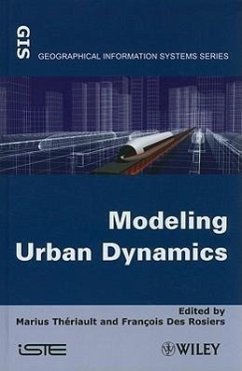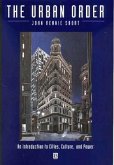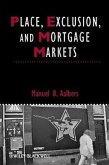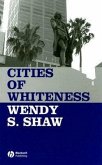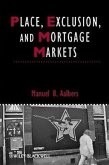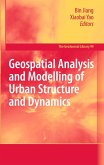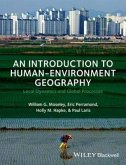Modeling Urban Dynamics
Mobility, Accessibility and Real Estate Value
Herausgeber: Thériault, Marius; Des Rosiers, François
Modeling Urban Dynamics
Mobility, Accessibility and Real Estate Value
Herausgeber: Thériault, Marius; Des Rosiers, François
- Gebundenes Buch
- Merkliste
- Auf die Merkliste
- Bewerten Bewerten
- Teilen
- Produkt teilen
- Produkterinnerung
- Produkterinnerung
"Adapted and updated from Information geographique et dynamiques urbaines published 2008 in France by Hermes Science/Lavoisier."
Andere Kunden interessierten sich auch für
![The Urban Order The Urban Order]() John Rennie ShortThe Urban Order185,99 €
John Rennie ShortThe Urban Order185,99 €![Place, Exclusion, and Mortgage Markets Place, Exclusion, and Mortgage Markets]() Manuel B AalbersPlace, Exclusion, and Mortgage Markets48,99 €
Manuel B AalbersPlace, Exclusion, and Mortgage Markets48,99 €![Cities of Whiteness Cities of Whiteness]() Wendy S ShawCities of Whiteness101,99 €
Wendy S ShawCities of Whiteness101,99 €![Military Geographies Military Geographies]() Rachel WoodwardMilitary Geographies49,99 €
Rachel WoodwardMilitary Geographies49,99 €![Place, Exclusion and Mortgage Markets Place, Exclusion and Mortgage Markets]() Manuel B AalbersPlace, Exclusion and Mortgage Markets103,99 €
Manuel B AalbersPlace, Exclusion and Mortgage Markets103,99 €![Geospatial Analysis and Modelling of Urban Structure and Dynamics Geospatial Analysis and Modelling of Urban Structure and Dynamics]() Bin Jiang / Xiaobai Yao (Hrsg.)Geospatial Analysis and Modelling of Urban Structure and Dynamics110,99 €
Bin Jiang / Xiaobai Yao (Hrsg.)Geospatial Analysis and Modelling of Urban Structure and Dynamics110,99 €![An Introduction to Human-Environment Geography An Introduction to Human-Environment Geography]() William G MoseleyAn Introduction to Human-Environment Geography67,99 €
William G MoseleyAn Introduction to Human-Environment Geography67,99 €-
-
-
"Adapted and updated from Information geographique et dynamiques urbaines published 2008 in France by Hermes Science/Lavoisier."
Hinweis: Dieser Artikel kann nur an eine deutsche Lieferadresse ausgeliefert werden.
Hinweis: Dieser Artikel kann nur an eine deutsche Lieferadresse ausgeliefert werden.
Produktdetails
- Produktdetails
- Verlag: Wiley
- Seitenzahl: 352
- Erscheinungstermin: 18. Januar 2011
- Englisch
- Abmessung: 234mm x 163mm x 23mm
- Gewicht: 640g
- ISBN-13: 9781848212688
- ISBN-10: 1848212682
- Artikelnr.: 30971426
- Herstellerkennzeichnung
- Libri GmbH
- Europaallee 1
- 36244 Bad Hersfeld
- 06621 890
- Verlag: Wiley
- Seitenzahl: 352
- Erscheinungstermin: 18. Januar 2011
- Englisch
- Abmessung: 234mm x 163mm x 23mm
- Gewicht: 640g
- ISBN-13: 9781848212688
- ISBN-10: 1848212682
- Artikelnr.: 30971426
- Herstellerkennzeichnung
- Libri GmbH
- Europaallee 1
- 36244 Bad Hersfeld
- 06621 890
Marius Thériault is the editor of Modeling Urban Dynamics: Mobility, Accessibility and Real Estate Value, published by Wiley. François Des Rosiers is the editor of Modeling Urban Dynamics: Mobility, Accessibility and Real Estate Value, published by Wiley.
Introduction xiii
Marius THÉRIAULT and François DES ROSIERS
Chapter 1. The Role of Mobility in the Building of Metropolitan
Polycentrism 1
Sandrine BERROIR, Hélène MATHIAN, Thérèse SAINT-JULIEN and Lena SANDERS
1.1. Introduction 1
1.2. Identification of centers and sub-centers 2
1.3. Polycentric functioning in two metropolitan contexts 13
1.4. Conclusion 23
1.5. Acknowledgements 23
1.6. Bibliography 24
Chapter 2. Commuting and Gender: Two Cities, One Reality? 27
Marie-Hélène VANDERSMISSEN, Isabelle THOMAS and Ann VERHETSEL
2.1. Commuting, gender and urban dynamics 27
2.2. Commuting and gender in Belgium 32
2.3. Commuting and gender in Québec City 38
2.4. Québec City and Brussels: two cities, one reality? 49
2.5. Acknowledgements 50
2.6. Bibliography 50
Chapter 3. Spatiotemporal Modeling of Destination Choices for Consumption
Purposes: Market Areas Delineation and Market Share Estimation 57
Gjin BIBA and Paul VILLENEUVE
3.1. Introduction 57
3.2. Main approaches to the spatial analysis of retail activity 59
3.3. Modeling market areas and consumer destination choices 67
3.4. Conclusion 76
3.5. Acknowledgements 77
3.6. Bibliography 78
Chapter 4. Generation of Potential Fields and Route Simulation Based on the
Household Travel Survey 83
Arnaud BANOS and Thomas THÉVENIN
4.1. Introduction 83
4.2. Rebuilding the virtual city 84
4.3. From the city in motion to individual trajectories 91
4.4. Conclusion 97
4.5. Bibliography 98
Chapter 5. Impacts of Road Networks on Urban Mobility 103
Jean-Christophe FOLTÊTE, Cyrille GENRE-GRANDPIERRE and Didier JOSSELIN
5.1. Introduction 103
5.2. The urban road network: a major determinant of pedestrian flow 105
5.3. Influence of the road network on the efficiency of a transportation
service 110
5.4. Road network metrics, urban sprawl and car dependency 117
5.5. Conclusion 123
5.6. Acknowledgements 124
5.7. Bibliography 124
Chapter 6. Daily Mobility and Urban Form: Constancy in Visited and
Represented Places as Indicators of Environmental Values 129
Thierry RAMADIER, Chryssanthi PETROPOULOU, Hélène HANIOTOU, Anne-Christine
BRONNER and Christophe ENAUX
6.1. Introduction 129
6.2. From landscape to eco-landscape 131
6.3. Behavioral and representational data collection 142
6.4. Behavioral and representational data processing 147
6.5. An application example: the Cronenbourg district pensioners' mobility
149
6.6. Conclusion 154
6.7. Acknowledgements 155
6.8. Bibliography 155
Chapter 7. Household Residential Choices upon Acquiring a Single-Family
House 159
Yan KESTENS, Marius THÉRIAULT and François DES ROSIERS
7.1. Introduction 159
7.2. Spatial cognition and perception of activity places 160
7.3. Residential mobility 162
7.4. Residential choice and location 163
7.5. Mobility survey and residential choices in Québec City 164
7.6. Conjoint modeling of household stated preferences 173
7.7. Discussion and conclusion 179
7.8. Acknowledgments 182
7.9. Bibliography 182
Chapter 8. Distances, Accessibility and Spatial Diffusion 189
Pierre DUMOLARD
8.1. Introduction 189
8.2. Distance, distances? 190
8.3. Spatial accessibility 192
8.4. Accessibility and spatial diffusion 198
8.5. Conclusion 202
8.6. Bibliography 203
Chapter 9. Accessibility to Proximity Services in Poor Areas of the Island
of Montreal 205
Philippe APPARICIO and Anne-Marie SÉGUIN
9.1. Introduction 205
9.2. Data 206
9.3. Methodology for measuring accessibility of services 206
9.4. Methodological approach: designing an accessibility indicator 215
9.5. The findings 215
9.6. Conclusion 220
9.7. Bibliography 221
Chapter 10. Accessibility of Urban Services: Modeling Socio-spatial
Differences and their Impacts on Residential Values 225
Marius THÉRIAULT, Marion VOISIN and François DES ROSIERS
10.1. Introduction 225
10.2. The perceptual and social components of accessibility 227
10.3. Centrality, relative and differential accessibilities 229
10.4. Modeling the impact of accessibility on residential values 238
10.5. Conclusion 251
10.6. Acknowledgements 252
10.7. Bibliography 252
Chapter 11. Hedonic Price Modeling: Measuring Urban Externalities in Québec
255
François DES ROSIERS, Jean DUBÉ and Marius THÉRIAULT
11.1. Introduction 255
11.2. Hedonic modeling and the microeconomic theory 258
11.3. Measuring urban externalities: market segmentation and functional
form issues 260
11.4. Econometric issues and implicit price estimation 265
11.5. The hedonic approach and measure of externalities: some examples 268
11.6. Conclusion 278
11.7. Acknowledgements 279
11.8. Bibliography 279
Chapter 12. The Value of Peri-urban Landscapes in a French Real Estate
Market 285
Thierry BROSSARD, Jean CAVAILHÈS, Mohamed HILAL, Daniel JOLY,
François-Pierre TOURNEUX and Pierre WAVRESKY
12.1. Introduction 285
12.2. Real estate and landscape data 286
12.3. Geographic and econometric models 291
12.4. Results 297
12.5. Conclusion 304
12.6. Acknowledgements 304
12.7. Bibliography 304
Chapter 13. Conclusion 307
Marius THÉRIAULT and François DES ROSIERS
13.1. Acknowledgements 311
13.2. Bibliography 311
List of Authors 313
Index 317
Marius THÉRIAULT and François DES ROSIERS
Chapter 1. The Role of Mobility in the Building of Metropolitan
Polycentrism 1
Sandrine BERROIR, Hélène MATHIAN, Thérèse SAINT-JULIEN and Lena SANDERS
1.1. Introduction 1
1.2. Identification of centers and sub-centers 2
1.3. Polycentric functioning in two metropolitan contexts 13
1.4. Conclusion 23
1.5. Acknowledgements 23
1.6. Bibliography 24
Chapter 2. Commuting and Gender: Two Cities, One Reality? 27
Marie-Hélène VANDERSMISSEN, Isabelle THOMAS and Ann VERHETSEL
2.1. Commuting, gender and urban dynamics 27
2.2. Commuting and gender in Belgium 32
2.3. Commuting and gender in Québec City 38
2.4. Québec City and Brussels: two cities, one reality? 49
2.5. Acknowledgements 50
2.6. Bibliography 50
Chapter 3. Spatiotemporal Modeling of Destination Choices for Consumption
Purposes: Market Areas Delineation and Market Share Estimation 57
Gjin BIBA and Paul VILLENEUVE
3.1. Introduction 57
3.2. Main approaches to the spatial analysis of retail activity 59
3.3. Modeling market areas and consumer destination choices 67
3.4. Conclusion 76
3.5. Acknowledgements 77
3.6. Bibliography 78
Chapter 4. Generation of Potential Fields and Route Simulation Based on the
Household Travel Survey 83
Arnaud BANOS and Thomas THÉVENIN
4.1. Introduction 83
4.2. Rebuilding the virtual city 84
4.3. From the city in motion to individual trajectories 91
4.4. Conclusion 97
4.5. Bibliography 98
Chapter 5. Impacts of Road Networks on Urban Mobility 103
Jean-Christophe FOLTÊTE, Cyrille GENRE-GRANDPIERRE and Didier JOSSELIN
5.1. Introduction 103
5.2. The urban road network: a major determinant of pedestrian flow 105
5.3. Influence of the road network on the efficiency of a transportation
service 110
5.4. Road network metrics, urban sprawl and car dependency 117
5.5. Conclusion 123
5.6. Acknowledgements 124
5.7. Bibliography 124
Chapter 6. Daily Mobility and Urban Form: Constancy in Visited and
Represented Places as Indicators of Environmental Values 129
Thierry RAMADIER, Chryssanthi PETROPOULOU, Hélène HANIOTOU, Anne-Christine
BRONNER and Christophe ENAUX
6.1. Introduction 129
6.2. From landscape to eco-landscape 131
6.3. Behavioral and representational data collection 142
6.4. Behavioral and representational data processing 147
6.5. An application example: the Cronenbourg district pensioners' mobility
149
6.6. Conclusion 154
6.7. Acknowledgements 155
6.8. Bibliography 155
Chapter 7. Household Residential Choices upon Acquiring a Single-Family
House 159
Yan KESTENS, Marius THÉRIAULT and François DES ROSIERS
7.1. Introduction 159
7.2. Spatial cognition and perception of activity places 160
7.3. Residential mobility 162
7.4. Residential choice and location 163
7.5. Mobility survey and residential choices in Québec City 164
7.6. Conjoint modeling of household stated preferences 173
7.7. Discussion and conclusion 179
7.8. Acknowledgments 182
7.9. Bibliography 182
Chapter 8. Distances, Accessibility and Spatial Diffusion 189
Pierre DUMOLARD
8.1. Introduction 189
8.2. Distance, distances? 190
8.3. Spatial accessibility 192
8.4. Accessibility and spatial diffusion 198
8.5. Conclusion 202
8.6. Bibliography 203
Chapter 9. Accessibility to Proximity Services in Poor Areas of the Island
of Montreal 205
Philippe APPARICIO and Anne-Marie SÉGUIN
9.1. Introduction 205
9.2. Data 206
9.3. Methodology for measuring accessibility of services 206
9.4. Methodological approach: designing an accessibility indicator 215
9.5. The findings 215
9.6. Conclusion 220
9.7. Bibliography 221
Chapter 10. Accessibility of Urban Services: Modeling Socio-spatial
Differences and their Impacts on Residential Values 225
Marius THÉRIAULT, Marion VOISIN and François DES ROSIERS
10.1. Introduction 225
10.2. The perceptual and social components of accessibility 227
10.3. Centrality, relative and differential accessibilities 229
10.4. Modeling the impact of accessibility on residential values 238
10.5. Conclusion 251
10.6. Acknowledgements 252
10.7. Bibliography 252
Chapter 11. Hedonic Price Modeling: Measuring Urban Externalities in Québec
255
François DES ROSIERS, Jean DUBÉ and Marius THÉRIAULT
11.1. Introduction 255
11.2. Hedonic modeling and the microeconomic theory 258
11.3. Measuring urban externalities: market segmentation and functional
form issues 260
11.4. Econometric issues and implicit price estimation 265
11.5. The hedonic approach and measure of externalities: some examples 268
11.6. Conclusion 278
11.7. Acknowledgements 279
11.8. Bibliography 279
Chapter 12. The Value of Peri-urban Landscapes in a French Real Estate
Market 285
Thierry BROSSARD, Jean CAVAILHÈS, Mohamed HILAL, Daniel JOLY,
François-Pierre TOURNEUX and Pierre WAVRESKY
12.1. Introduction 285
12.2. Real estate and landscape data 286
12.3. Geographic and econometric models 291
12.4. Results 297
12.5. Conclusion 304
12.6. Acknowledgements 304
12.7. Bibliography 304
Chapter 13. Conclusion 307
Marius THÉRIAULT and François DES ROSIERS
13.1. Acknowledgements 311
13.2. Bibliography 311
List of Authors 313
Index 317
Introduction xiii
Marius THÉRIAULT and François DES ROSIERS
Chapter 1. The Role of Mobility in the Building of Metropolitan
Polycentrism 1
Sandrine BERROIR, Hélène MATHIAN, Thérèse SAINT-JULIEN and Lena SANDERS
1.1. Introduction 1
1.2. Identification of centers and sub-centers 2
1.3. Polycentric functioning in two metropolitan contexts 13
1.4. Conclusion 23
1.5. Acknowledgements 23
1.6. Bibliography 24
Chapter 2. Commuting and Gender: Two Cities, One Reality? 27
Marie-Hélène VANDERSMISSEN, Isabelle THOMAS and Ann VERHETSEL
2.1. Commuting, gender and urban dynamics 27
2.2. Commuting and gender in Belgium 32
2.3. Commuting and gender in Québec City 38
2.4. Québec City and Brussels: two cities, one reality? 49
2.5. Acknowledgements 50
2.6. Bibliography 50
Chapter 3. Spatiotemporal Modeling of Destination Choices for Consumption
Purposes: Market Areas Delineation and Market Share Estimation 57
Gjin BIBA and Paul VILLENEUVE
3.1. Introduction 57
3.2. Main approaches to the spatial analysis of retail activity 59
3.3. Modeling market areas and consumer destination choices 67
3.4. Conclusion 76
3.5. Acknowledgements 77
3.6. Bibliography 78
Chapter 4. Generation of Potential Fields and Route Simulation Based on the
Household Travel Survey 83
Arnaud BANOS and Thomas THÉVENIN
4.1. Introduction 83
4.2. Rebuilding the virtual city 84
4.3. From the city in motion to individual trajectories 91
4.4. Conclusion 97
4.5. Bibliography 98
Chapter 5. Impacts of Road Networks on Urban Mobility 103
Jean-Christophe FOLTÊTE, Cyrille GENRE-GRANDPIERRE and Didier JOSSELIN
5.1. Introduction 103
5.2. The urban road network: a major determinant of pedestrian flow 105
5.3. Influence of the road network on the efficiency of a transportation
service 110
5.4. Road network metrics, urban sprawl and car dependency 117
5.5. Conclusion 123
5.6. Acknowledgements 124
5.7. Bibliography 124
Chapter 6. Daily Mobility and Urban Form: Constancy in Visited and
Represented Places as Indicators of Environmental Values 129
Thierry RAMADIER, Chryssanthi PETROPOULOU, Hélène HANIOTOU, Anne-Christine
BRONNER and Christophe ENAUX
6.1. Introduction 129
6.2. From landscape to eco-landscape 131
6.3. Behavioral and representational data collection 142
6.4. Behavioral and representational data processing 147
6.5. An application example: the Cronenbourg district pensioners' mobility
149
6.6. Conclusion 154
6.7. Acknowledgements 155
6.8. Bibliography 155
Chapter 7. Household Residential Choices upon Acquiring a Single-Family
House 159
Yan KESTENS, Marius THÉRIAULT and François DES ROSIERS
7.1. Introduction 159
7.2. Spatial cognition and perception of activity places 160
7.3. Residential mobility 162
7.4. Residential choice and location 163
7.5. Mobility survey and residential choices in Québec City 164
7.6. Conjoint modeling of household stated preferences 173
7.7. Discussion and conclusion 179
7.8. Acknowledgments 182
7.9. Bibliography 182
Chapter 8. Distances, Accessibility and Spatial Diffusion 189
Pierre DUMOLARD
8.1. Introduction 189
8.2. Distance, distances? 190
8.3. Spatial accessibility 192
8.4. Accessibility and spatial diffusion 198
8.5. Conclusion 202
8.6. Bibliography 203
Chapter 9. Accessibility to Proximity Services in Poor Areas of the Island
of Montreal 205
Philippe APPARICIO and Anne-Marie SÉGUIN
9.1. Introduction 205
9.2. Data 206
9.3. Methodology for measuring accessibility of services 206
9.4. Methodological approach: designing an accessibility indicator 215
9.5. The findings 215
9.6. Conclusion 220
9.7. Bibliography 221
Chapter 10. Accessibility of Urban Services: Modeling Socio-spatial
Differences and their Impacts on Residential Values 225
Marius THÉRIAULT, Marion VOISIN and François DES ROSIERS
10.1. Introduction 225
10.2. The perceptual and social components of accessibility 227
10.3. Centrality, relative and differential accessibilities 229
10.4. Modeling the impact of accessibility on residential values 238
10.5. Conclusion 251
10.6. Acknowledgements 252
10.7. Bibliography 252
Chapter 11. Hedonic Price Modeling: Measuring Urban Externalities in Québec
255
François DES ROSIERS, Jean DUBÉ and Marius THÉRIAULT
11.1. Introduction 255
11.2. Hedonic modeling and the microeconomic theory 258
11.3. Measuring urban externalities: market segmentation and functional
form issues 260
11.4. Econometric issues and implicit price estimation 265
11.5. The hedonic approach and measure of externalities: some examples 268
11.6. Conclusion 278
11.7. Acknowledgements 279
11.8. Bibliography 279
Chapter 12. The Value of Peri-urban Landscapes in a French Real Estate
Market 285
Thierry BROSSARD, Jean CAVAILHÈS, Mohamed HILAL, Daniel JOLY,
François-Pierre TOURNEUX and Pierre WAVRESKY
12.1. Introduction 285
12.2. Real estate and landscape data 286
12.3. Geographic and econometric models 291
12.4. Results 297
12.5. Conclusion 304
12.6. Acknowledgements 304
12.7. Bibliography 304
Chapter 13. Conclusion 307
Marius THÉRIAULT and François DES ROSIERS
13.1. Acknowledgements 311
13.2. Bibliography 311
List of Authors 313
Index 317
Marius THÉRIAULT and François DES ROSIERS
Chapter 1. The Role of Mobility in the Building of Metropolitan
Polycentrism 1
Sandrine BERROIR, Hélène MATHIAN, Thérèse SAINT-JULIEN and Lena SANDERS
1.1. Introduction 1
1.2. Identification of centers and sub-centers 2
1.3. Polycentric functioning in two metropolitan contexts 13
1.4. Conclusion 23
1.5. Acknowledgements 23
1.6. Bibliography 24
Chapter 2. Commuting and Gender: Two Cities, One Reality? 27
Marie-Hélène VANDERSMISSEN, Isabelle THOMAS and Ann VERHETSEL
2.1. Commuting, gender and urban dynamics 27
2.2. Commuting and gender in Belgium 32
2.3. Commuting and gender in Québec City 38
2.4. Québec City and Brussels: two cities, one reality? 49
2.5. Acknowledgements 50
2.6. Bibliography 50
Chapter 3. Spatiotemporal Modeling of Destination Choices for Consumption
Purposes: Market Areas Delineation and Market Share Estimation 57
Gjin BIBA and Paul VILLENEUVE
3.1. Introduction 57
3.2. Main approaches to the spatial analysis of retail activity 59
3.3. Modeling market areas and consumer destination choices 67
3.4. Conclusion 76
3.5. Acknowledgements 77
3.6. Bibliography 78
Chapter 4. Generation of Potential Fields and Route Simulation Based on the
Household Travel Survey 83
Arnaud BANOS and Thomas THÉVENIN
4.1. Introduction 83
4.2. Rebuilding the virtual city 84
4.3. From the city in motion to individual trajectories 91
4.4. Conclusion 97
4.5. Bibliography 98
Chapter 5. Impacts of Road Networks on Urban Mobility 103
Jean-Christophe FOLTÊTE, Cyrille GENRE-GRANDPIERRE and Didier JOSSELIN
5.1. Introduction 103
5.2. The urban road network: a major determinant of pedestrian flow 105
5.3. Influence of the road network on the efficiency of a transportation
service 110
5.4. Road network metrics, urban sprawl and car dependency 117
5.5. Conclusion 123
5.6. Acknowledgements 124
5.7. Bibliography 124
Chapter 6. Daily Mobility and Urban Form: Constancy in Visited and
Represented Places as Indicators of Environmental Values 129
Thierry RAMADIER, Chryssanthi PETROPOULOU, Hélène HANIOTOU, Anne-Christine
BRONNER and Christophe ENAUX
6.1. Introduction 129
6.2. From landscape to eco-landscape 131
6.3. Behavioral and representational data collection 142
6.4. Behavioral and representational data processing 147
6.5. An application example: the Cronenbourg district pensioners' mobility
149
6.6. Conclusion 154
6.7. Acknowledgements 155
6.8. Bibliography 155
Chapter 7. Household Residential Choices upon Acquiring a Single-Family
House 159
Yan KESTENS, Marius THÉRIAULT and François DES ROSIERS
7.1. Introduction 159
7.2. Spatial cognition and perception of activity places 160
7.3. Residential mobility 162
7.4. Residential choice and location 163
7.5. Mobility survey and residential choices in Québec City 164
7.6. Conjoint modeling of household stated preferences 173
7.7. Discussion and conclusion 179
7.8. Acknowledgments 182
7.9. Bibliography 182
Chapter 8. Distances, Accessibility and Spatial Diffusion 189
Pierre DUMOLARD
8.1. Introduction 189
8.2. Distance, distances? 190
8.3. Spatial accessibility 192
8.4. Accessibility and spatial diffusion 198
8.5. Conclusion 202
8.6. Bibliography 203
Chapter 9. Accessibility to Proximity Services in Poor Areas of the Island
of Montreal 205
Philippe APPARICIO and Anne-Marie SÉGUIN
9.1. Introduction 205
9.2. Data 206
9.3. Methodology for measuring accessibility of services 206
9.4. Methodological approach: designing an accessibility indicator 215
9.5. The findings 215
9.6. Conclusion 220
9.7. Bibliography 221
Chapter 10. Accessibility of Urban Services: Modeling Socio-spatial
Differences and their Impacts on Residential Values 225
Marius THÉRIAULT, Marion VOISIN and François DES ROSIERS
10.1. Introduction 225
10.2. The perceptual and social components of accessibility 227
10.3. Centrality, relative and differential accessibilities 229
10.4. Modeling the impact of accessibility on residential values 238
10.5. Conclusion 251
10.6. Acknowledgements 252
10.7. Bibliography 252
Chapter 11. Hedonic Price Modeling: Measuring Urban Externalities in Québec
255
François DES ROSIERS, Jean DUBÉ and Marius THÉRIAULT
11.1. Introduction 255
11.2. Hedonic modeling and the microeconomic theory 258
11.3. Measuring urban externalities: market segmentation and functional
form issues 260
11.4. Econometric issues and implicit price estimation 265
11.5. The hedonic approach and measure of externalities: some examples 268
11.6. Conclusion 278
11.7. Acknowledgements 279
11.8. Bibliography 279
Chapter 12. The Value of Peri-urban Landscapes in a French Real Estate
Market 285
Thierry BROSSARD, Jean CAVAILHÈS, Mohamed HILAL, Daniel JOLY,
François-Pierre TOURNEUX and Pierre WAVRESKY
12.1. Introduction 285
12.2. Real estate and landscape data 286
12.3. Geographic and econometric models 291
12.4. Results 297
12.5. Conclusion 304
12.6. Acknowledgements 304
12.7. Bibliography 304
Chapter 13. Conclusion 307
Marius THÉRIAULT and François DES ROSIERS
13.1. Acknowledgements 311
13.2. Bibliography 311
List of Authors 313
Index 317

